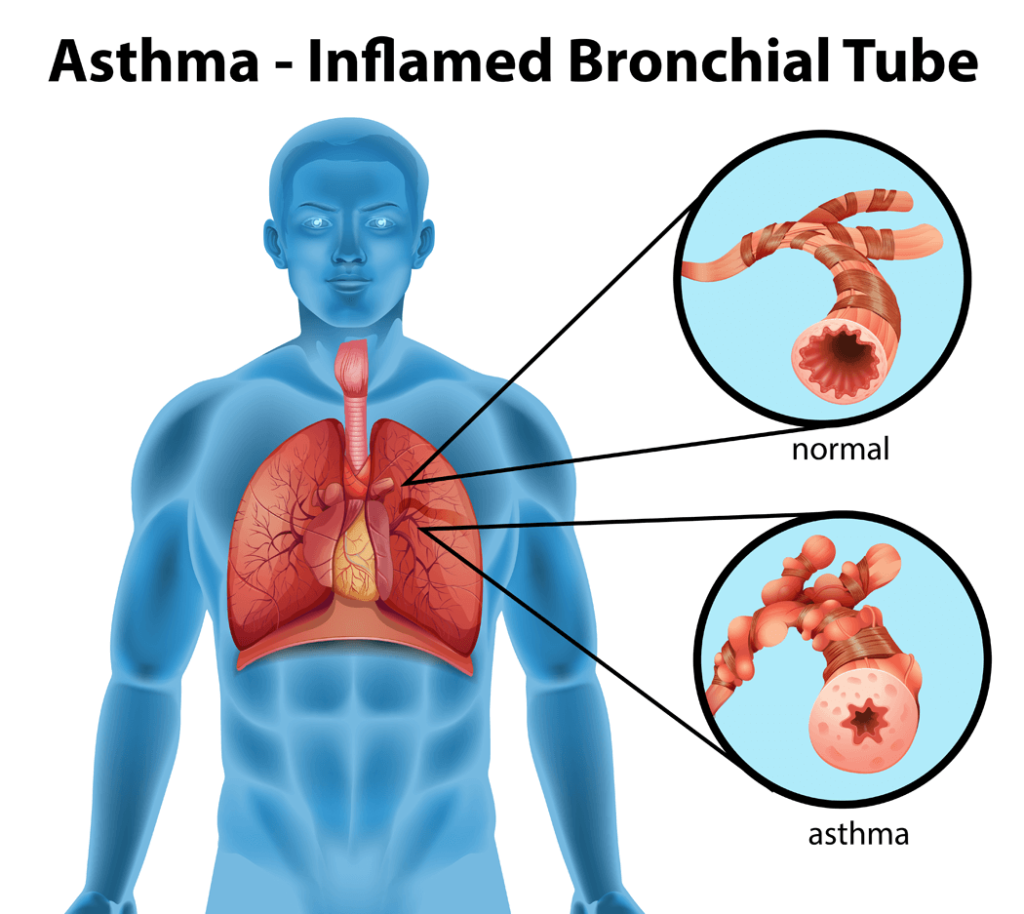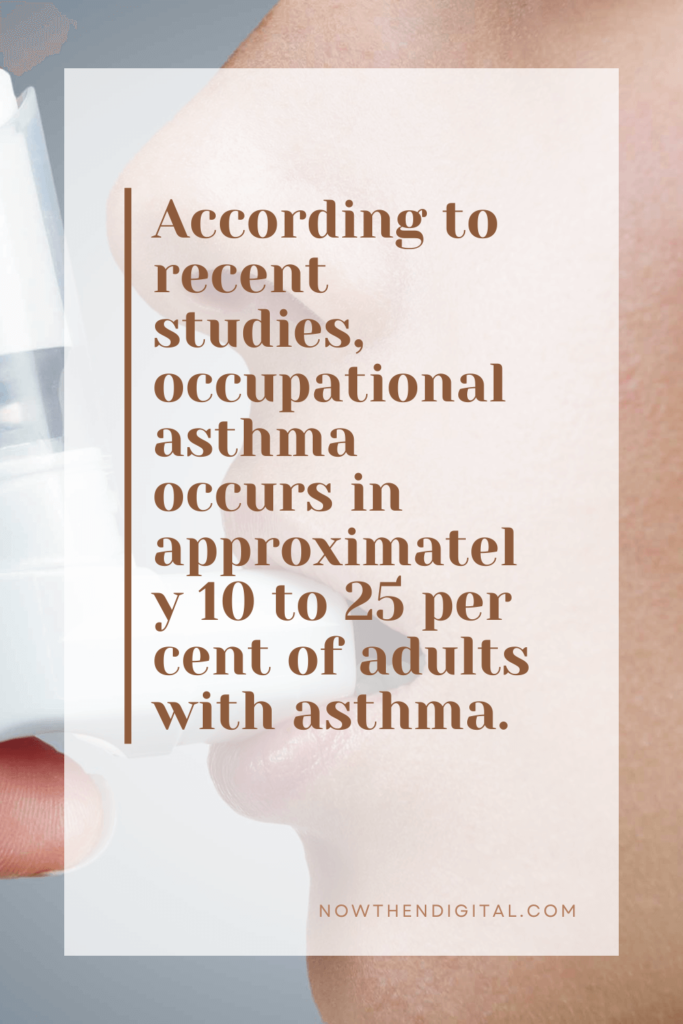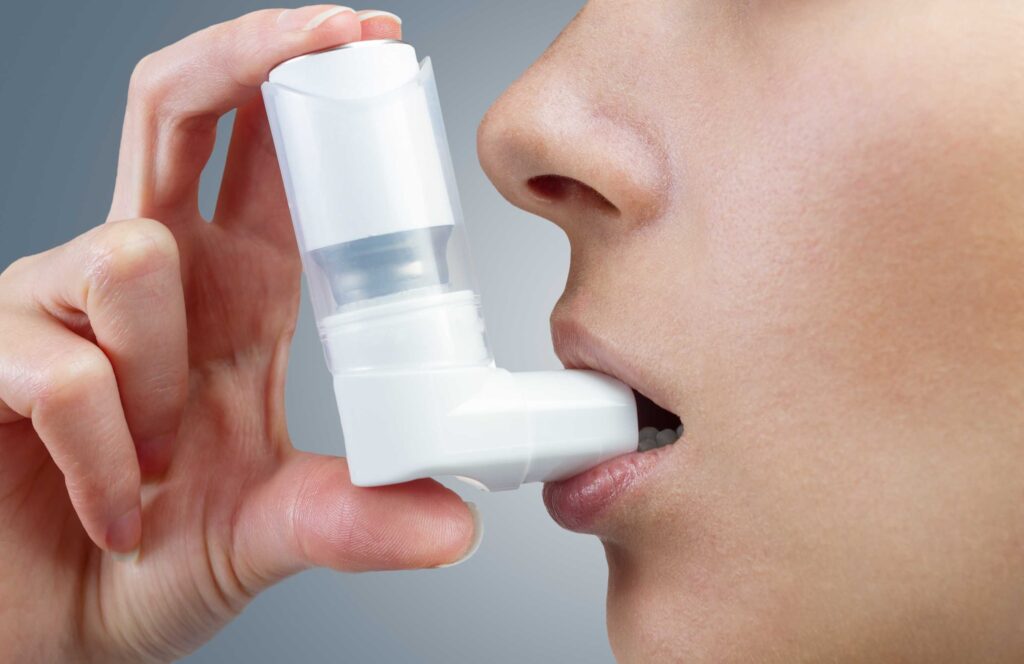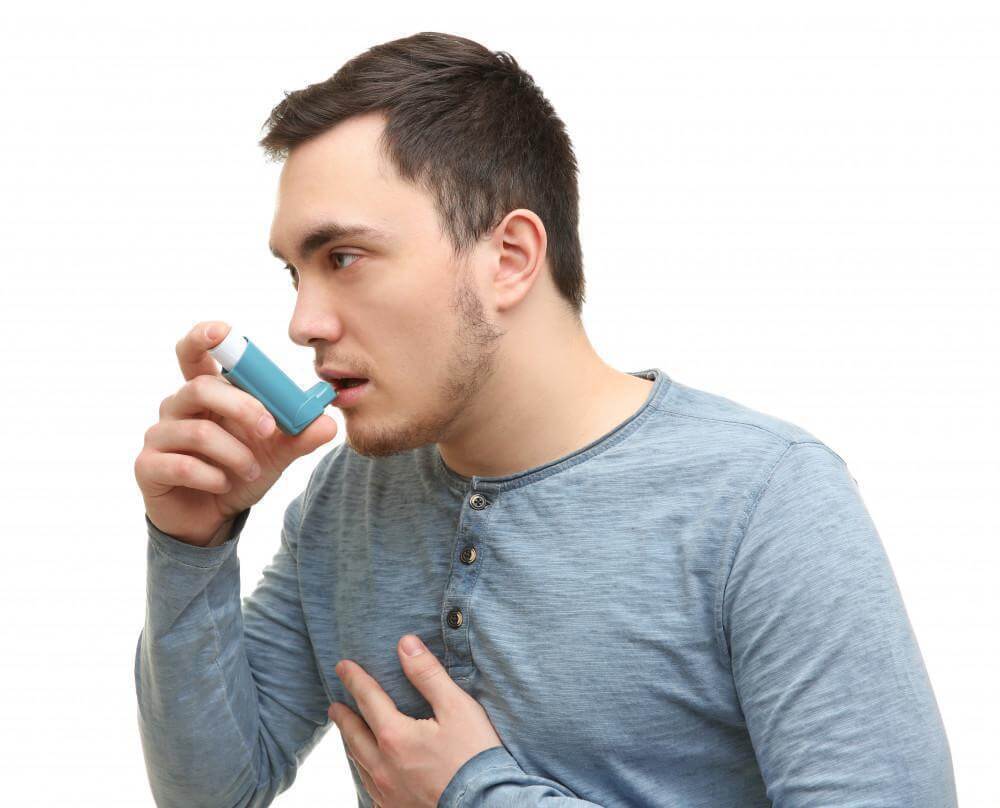The duration of an asthma attack can vary based on the severity of the attack, the age and health of the person, and the type of medications they are taking.
CUPERTINO, CALIFORNIA | NOW THEN DIGITAL — An asthma attack occurs when the airways become inflamed and narrowed, making it difficult for a person to breathe. This can be triggered by allergens, cold air, exercise, or other factors.
- Common medications for asthma include bronchodilators, such as albuterol and salmeterol, and corticosteroids, such as fluticasone and beclomethasone.
- Bronchodilators, leukotriene modifiers, anti-IgE therapy, and immunomodulators are other treatments that are used to help reduce the body’s response to allergens, open up the airways, and target and reduce inflammation in the airways.
- The most common side effects of inhaled corticosteroids are a sore mouth or throat, a hoarse or croaky voice, a cough, oral thrush, and nosebleeds.
- Herbal teas are known to be beneficial for people with asthma. Herbal teas made with ingredients such as ginger, turmeric, and green tea can help reduce inflammation in the airways, which is often a symptom of asthma. They can also help to reduce mucus production, making it easier to breathe.
As the airways become inflamed and narrowed, the muscles around them can tighten, further restricting airflow. The airways can also become filled with mucus, which can make it even more difficult to breathe.
These symptoms can be very frightening for the person experiencing them.
What is an asthma attack?

An asthma attack is a sudden worsening of symptoms due to narrowing of the airways, leading to difficulty breathing.
During an asthma attack, the muscles around the airways tighten and the lining of the airways swells, leading to a decrease in the amount of air that can pass through. This can cause shortness of breath, wheezing, coughing, and chest tightness.
Bronchodilators and corticosteroids help to relax the muscles and reduce inflammation, allowing air to flow more easily through the airways.
The bronchodilators work by widening the airways, while the corticosteroids reduce swelling in the airways, which helps to reduce the difficulty of breathing.
Together, these medications can help to improve the symptoms of an asthma attack. More than 3,500 people die from asthma each year, with children more likely to have an attack than adults.
What is the main cause of asthma?

The main cause of asthma is unknown, but it is believed to be caused by a combination of environmental and genetic factors.
Exposure to certain environmental triggers such as smoke, dust mites, pollen, and pet dander can cause asthma symptoms to flare up.
Additionally, family history and certain genetic factors can make a person more prone to developing asthma. In some cases, a severe viral infection in early childhood can also trigger the onset of asthma.
In addition, lifestyle factors such as smoking and a poor diet can exacerbate asthma symptoms. Children who have parents with asthma are more likely to develop the condition themselves, with a 25% chance if one parent has asthma.
This is because certain genes that are linked to asthma can be passed on from parent to child. Also, if a child’s environment is full of triggers such as dust, pet dander, and smoke, they may be more likely to develop asthma.
For example, children who grow up in households with smokers are at a higher risk of developing asthma compared to those with non-smoking parents.
Therefore, it is essential to create a safe and healthy environment for children to help reduce their likelihood of developing asthma.
What are the 3 types of asthma?
The three types of asthma are allergic asthma, exercise-induced asthma, and occupational asthma. Allergic asthma is triggered by allergens such as dust, pollen, or pet dander.
Exercise-induced asthma is triggered by vigorous physical activity. Occupational asthma is triggered by certain irritants in a work environment.
Allergic asthma is caused by an allergic reaction and can cause symptoms such as coughing, wheezing, chest tightness, and shortness of breath when exposed to the allergen.
Exercise-induced asthma is caused by the physical effort of exercise and can cause difficulty breathing, chest tightness, and coughing during exercise.
Occupational asthma is caused by exposure to certain irritants in a work environment, such as dust, fumes, or certain chemicals, and can cause symptoms such as coughing, wheezing, and chest tightness when exposed to the irritant.
For example, people who work in woodworking, grain processing, and other industries that involve exposure to wood dust, grain dust, and certain chemicals may be at risk for developing occupational asthma.
It is estimated that between 10 and 25 percent of adults with asthma suffer from occupational asthma at some point in their lives.
How do you know if you have asthma?

Symptoms of asthma can include shortness of breath, wheezing, coughing, chest tightness, and difficulty breathing. If you experience any of these symptoms, it is important to see a healthcare professional for a diagnosis.
A healthcare professional can perform a physical exam and run tests to determine if you have asthma. These tests may include a spirometry test, an allergy test, or an imaging test.
It is important to get an accurate diagnosis so that you can get the right treatment to manage your symptoms. According to recent data, 8.3% of Americans have asthma.
This comes out to around 26.5 million people, with 20.4 million of them being adults and 6.1 million being children. It is important to get an accurate diagnosis because asthma is a chronic condition that can be managed with the right treatment.
However, without an accurate diagnosis, it can be difficult to get the right treatment and manage symptoms. An accurate diagnosis can also help prevent asthma attacks, which are often triggered by environmental factors.
For example, if someone is diagnosed with asthma, they can take steps to remove any possible triggers from their environment, such as pet dander or dust, and use medications to prevent or reduce the severity of asthma attacks.
By properly managing asthma and its symptoms, people can significantly reduce their risk of an asthma attack and lead an active and healthy life.
What is the most popular asthma medication?

The most popular asthma medication is an inhaled corticosteroid, which works to reduce inflammation in the airways.
Other treatments include bronchodilators, which open up the airways, leukotriene modifiers, which help control the body’s response to allergens, anti-IgE therapy, which helps reduce the body’s response to allergens, and immunomodulators, which help target and reduce inflammation in the airways.
Inhaled corticosteroids are the most widely used and recommended treatment for asthma, as they reduce inflammation in the airways and can help control and prevent symptoms.
These medications work by blocking the action of certain substances, such as histamine, that are involved in triggering and maintaining an allergic response. They also reduce inflammation in the airways, which helps to open up the airways and makes it easier to breathe.
The side effects of inhaled corticosteroids depend on the dosage, but they typically include a sore throat and mouth, a hoarse or croaky voice, a cough, and nosebleeds. In rare cases, they can also cause oral thrush.
Asthma attacks without inhalers: what do you do?

If you’re having an asthma attack and don’t have an inhaler, the best thing to do is to sit up and lean forward to open up the airways and slow your breathing.
Try to stay calm and avoid activities that can increase your breathing and make the asthma attack worse. 40.4% of adults age 18 and older who have asthma reported having one or more asthma attacks in the past year.
Another technique is to use a cool-mist humidifier or take a warm bath or shower, as this can help to loosen the airways and make it easier to breathe.
To further reduce the risk of an asthma attack, it is important to identify and avoid triggers, such as pet dander, smoking, dust, and pollen.
Additionally, asthma can be managed with the help of an asthma action plan, which includes instructions on how to handle different symptoms and when to seek medical assistance.
How long do asthma attacks last?
An asthma attack can last anywhere from a few minutes to several hours, depending on the severity. Asthma attacks can also become more severe over time if not treated, thus leading to longer duration of the attack.
Most asthma attacks will typically last between 5 and 20 minutes, but they can last longer if the person is not treated or if the attack is particularly intense.
In addition, managing asthma with an ongoing asthma treatment plan, such as taking preventive medications, can help reduce the severity and duration of an asthma attack.
Can you die from an asthma attack?

Yes, it is possible to die from an asthma attack. When the airways narrow due to an asthma attack, oxygen levels in the body decrease, and if left untreated, can lead to severe hypoxemia, which can cause death.
Approximately 4,000 people die from asthma each year in the United States, and it is a contributing factor in nearly 7,000 other deaths.
In severe cases, the airways can become so constricted that not enough oxygen can pass through to the lungs, leading to a potentially fatal condition known as respiratory failure.
Additionally, asthma attacks can also cause the airways to swell up and become blocked, further cutting off the oxygen supply to the lungs.
What drink is good for asthma?
Many people find that drinking ginger tea can be beneficial for asthma symptoms. Ginger has anti-inflammatory properties which can help to reduce inflammation in the airways and provide relief from asthma.
Additionally, it is high in antioxidants which can help to reduce oxidative stress in the body, which can also help to reduce asthma symptoms.
Ginger tea is not the only drink that is beneficial for asthma symptoms. Other herbal teas, such as chamomile and peppermint, can also provide relief. They can also help to reduce mucus production, making it easier to breathe.
Additionally, some research suggests that drinking lemon water can help to reduce asthma symptoms as well. However, while there is anecdotal evidence that drinking lemon water can help to reduce asthma symptoms, no scientific studies have been conducted to prove its effectiveness in treating asthma.
When to see a doctor for asthma?
You should see a doctor if you have symptoms of asthma such as coughing, wheezing, difficulty breathing, or tightness in the chest that is not relieved with over-the-counter medications.
You should also see a doctor if you find that your asthma symptoms are getting worse or if you are having more frequent asthma attacks.
Additionally, if you are using a rescue inhaler more than twice a week, or if you have to use the inhaler more often than prescribed, it is important to see a doctor. It is also important to get regular check-ups to make sure your asthma is well-controlled.
The National Asthma Education and Prevention Program recommends visits to a clinician every six months for patients whose asthma is under control, and more often for patients whose asthma is uncontrolled or has severe persistent asthma.
Staying on top of your asthma is the key to managing it effectively. Therefore, it is important to regularly check in with your doctor to ensure your asthma is well-controlled and to make any necessary adjustments to your treatment plan.
Editor’s Note: Please contact press@nowthendigital.com if you find any of the content to be inaccurate or outdated.
You’re reading nowthendigital.com — which breaks the news about Uganda, Kenya, Nigeria, South Africa and the rest of the world, day after day. Be sure to check out our homepage for all the latest news, and follow NOW THEN DIGITAL on YouTube, Google, Web Stories, Google News, Medium, Twitter, Reddit, Pinterest, Linktr, Buy Me a Coffee, and Flipboard to stay in the loop.
















